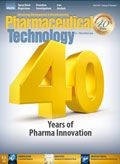Pharma’s Past Serves as Prologue to Its Future
The more pharma science and technology change, the more business and policy concerns stay the same.
martan/shutterstock.com

In the 40 years since Pharmaceutical Technology magazine was first published, the pharmaceutical industry has weathered shifts in medical, scientific, regulatory, and business practices to discover, develop, and manufacture medicines for patients globally. Genomic studies have provided insight into disease conditions. Materials research in particle sciences and nanotechnology have fostered advances in formulation and drug delivery. Biologic-based drugs have addressed previously untreated diseases. And advances in analytical technologies have enabled more comprehensive and accurate studies of cellular and chemical behavior.
The drug development and manufacturing process in 2017 is more technologically advanced, and has benefited from the application of scientific, risk-based approaches. Still, the industry faces challenges including shrinking internal pipelines, market-share incursions from generic drugs, regulatory inconsistencies from region to region, supply chain threats, aging equipment and facilities, drug pricing pressures, and investor demands for financial performance.
While the bio/pharmaceutical industry has witnessed many changes during the past 40 years, some sentiments expressed in 1977 still ring true. In a guest editorial the first issue of Pharmaceutical Technology (1), George H. Hopkins, president of the Parenteral Drug Association at the time, commented that pharmaceutical scientists and companies enjoyed the respect of society at large; however, he wrote, “the times, they are a-changing. Society is beginning to challenge many institutions and agencies that were once held in awe.”
People have lost faith in the integrity of elected officials, he continued, “due, in a large part, to demonstrated venality on the federal, state, and local levels.” And, he noted, “the pharmaceutical industry has been accused of setting prices that yield exorbitant profits on some drug products.”
Payer and policymaker concerns about the high cost of drug products continue today fueled by high-profile examples of price inflation by Turing Pharmaceuticals, under the leadership of Martin Shkreli, and Mylan Pharmaceuticals. The contentious debate over healthcare in the United States also centers on drug costs.
The rise and fall of the blockbuster
Patent expirations of blockbuster drugs have had a significant impact on the pharmaceutical companies and their approaches to research and development. As drug innovator companies lost exclusivity to high-revenue generating drugs in the early 2010s, Big Pharma adopted business alternatives such as developing drugs for unmet medical needs, adding generic-drug businesses, partnering with other companies, acquiring or licensing therapies from startup companies, or marketing their drug products in new geographic areas.
From 1977-2016, FDA approved, on average, 26 new molecular entities (NMEs) per year. The number of NMEs per year has trended slightly upward since 1977, with banner years for approvals in 1996 (53 approvals), 2014 (41 approvals), and 2015 (45 approvals) (2, 3).
In recent years, FDA’s expedited approval pathways--fast track, breakthrough, priority review, and accelerated approval--have played a major role in bringing new drugs, particularly for orphan or rare diseases, to market. Nearly three-quarters of the NMEs approved in 2016 were reviewed under one or more expedited approval pathway. Biologic-based drugs represent a growing share of the approved NMEs; small molecule drugs, however, remained the primary type of drug approved.
Managing regulatory oversight
In 1977, Hopkins lamented the “sometimes conflicting regulatory constraints” from a range of health and environmental agencies as “each new scientific discovery creates for society a fresh set of problems, and each new set of problems creates in turn new controls and a new bureaucracy to administer these controls.”
On the regulatory front, legislation, supporting regulations, and guidance documents shaped manufacturing practices and business approaches. Drug license holders looking to extend their product distribution to new geographic regions faced varying regulatory requirements and approval processes from region to region.
In 1978, 21 Code of Federal Regulations Parts 210 and 211 were issued, establishing good manufacturing practices for drug products. The Orphan Drug Act of 1983 provided incentives for drug companies to develop therapies for patients with rare diseases. Generic drugs gained an abbreviated approval pathway in 1984 via the Hatch-Waxman Act. The Prescription Drug User Fee Act of 1992 funded FDA resources to reduce the time needed for drug approvals.
More recently, the Patient Protection and Affordable Care Act of 2009 created an abbreviated licensure pathway for biological products that are “biosimilar” or “interchangeable” with an FDA-licensed biological product; a June 2017 Supreme Court decision eased the path for biosimilar approvals.
The Food and Drug Administration Safety and Innovation Act of 2012 established regulations for tracking drug products through the supply chain, measures needed to prevent global prescription drug theft and diversion. Implementation dates in the US, however, were extended as the industry struggled to meet deadlines.
The 21st Century Cures Act of 2016 provided alternatives to expedite clinical trials, encouraged patient involvement in drug development, and provided for FDA staffing to reduce a backlog of generic-drug applications.
Quality at the forefront
Pressures to lower manufacturing costs and improve the financial bottom line enticed drug license holders to seek less costly materials and manufacturing services offshore, often with limited US regulatory oversight. In addition, some companies were deterred from investing in new equipment or facilities due to low return on investment, or concerns about a costly post-approval change process. Resulting quality issues led to ongoing drug shortages, particularly for low-cost parenteral drugs.
In a 2017 Pharmaceutical Technology survey (4) of US bio/pharma quality and manufacturing professionals, respondents said that FDA could improve drug quality by inspecting more offshore facilities, and favored the use of self-reporting and inspection waivers to facilities that meet predefined quality metrics.
In recent years, FDA has stepped up inspections of API and drug product manufacturers and issued more warning letters to facilities in India and China. The agency also proposed proactive measures to address quality through a quality metrics program. After several years of industry study and debate, the program remained at the draft guidance stage as of June 2017.
Nearly half of the survey respondents who reported quality-related problems attributed the issues to human error and documentation practices; nearly one-third cited manufacturing-related issues.
During facility inspections in fiscal years 2012-2106 (5), however, FDA identified shortfalls in quality procedures and processes--a lack of written quality control procedures, lack of investigation to batch discrepancies, lack of scientifically sound laboratory controls, and a lack of written procedures for production and process controls--as the leading sources of quality issues.
Despite these agency findings, more than 40% of the respondents could not identify a formal quality management system used at their facility and many noted that their facilities lacked formal maintenance programs.
Technology of the times
Advertisements in the first issue of Pharmaceutical Technology promoted equipment, supplies, and materials-the predecessors of today’s technologies-including tablet coating and manufacturing systems, sterilizers, packaging components, tubing, filters and filter cartridges, freeze dryers, powder media, dissolution testing instruments, biohazard process isolation equipment, water purification systems, and particle counters.
Product descriptions reflected the technology of the era, which may seem dangerous or antiquated, by today’s standards. Several filter manufacturers noted that their products were “asbestos-free.” A data acquisition system was touted for its ability to gather information from a “computer-directed analyzer”, store it on a tape cartridge, and automatically collate and print results.
In 1977, high-performance liquid chromatography (HPLC) was gaining acceptance in pharmaceutical development. Since that time, HPLC, mass spectrometry, differential scanning calorimetry, and other instruments have become more sophisticated and accurate, providing more information about small molecules and biologics. These instruments have helped drug developers meet the requirements of orthogonal testing techniques encouraged by FDA.
The early application of computer-controlled pharmaceutical manufacturing was profiled in a February 1978 article (6) about Merck Sharp & Dohme’s $23 million ($89 million in 2017 dollars) “fully computer-controlled tableting plant” in Elkton, VA. The facility was opened to “launch America into a new era of pharmaceutical manufacturing that is as far removed from apothecarial compounding as the space shuttle is from the Pilgrims’ Mayflower.”
The facility featured the “awesome absence of human beings.” Two employees monitored computer operations; four people, with two-way radios, monitored a continuous production operation that had 420 regulating and sensing devices. The process included an aqueous coating process, continuous granulating and blending, continuous fluidizing of coating film, and a computer system to print data for batch records.
While this facility represented cutting edge technology in 1978, return on investment was an overriding concern. In the article, Merck Chairman and CEO John J. Horan noted that the innovation demonstrated in the plant would be threatened if public policy led to “government reimbursement at levels that do not support this kind of activity.”
Despite this early attempt at continuous manufacturing, batch processes remained the primary manufacturing approach in the ensuing decades. To address quality issues and reduce the potential of drug shortages, FDA encouraged drug makers to embrace modern manufacturing methods. The agency’s approval of two continuous manufacturing processes in 2016--a new manufacturing process and the transition of a legacy batch manufacturing process to continuous mode--has encouraged other drug manufacturers and contract manufacturers to explore continuous processing.
Other technology advances are discussed in the 40th anniversary section of this issue.
Lessons still to be learned
In the 1977 guest editorial, Hopkins warned about legislators and scientists operating in silos and not communicating, or intentionally ignoring advice. “If we accept the fact that many of today’s problems stem from technological advances evolving at a pace faster than our present ability to assimilate them, we must also recognize that these same technological capabilities are our major resource in developing solutions to our problems,” he wrote. “The scientist cannot continue to innovate in his ivory tower, leaving the potential applications of his new discoveries to outside agencies of uncertain technical competence.”
As technology and information channels advance at a rapid pace, and patient, payer, investor, and politically connected groups maneuver for a voice in the bio/pharma industry, the need for bio/pharmaceutical companies, industry suppliers, and regulators to innovate and communicate in concert once again rings true.
References
1. G. Hopkins, Pharm. Tech. 1 (1) 16-17.
2. FDA, New Drugs at FDA, www.fda.gov/Drugs/DevelopmentApprovalProcess/DrugInnovation/default.htm, accessed July 2, 2017.
3. FDA, Summary of NDA Approvals & Receipts, 1938 to the Present, www.fda.gov/aboutfda/whatwedo/history/productregulation/summaryofndaapprovalsreceipts1938tothepresent/default.htm accessed July 2, 2017.
4. Pharmaceutical Technology, “Quality Practices: Meeting and Exceeding Regulatory Expectations,” Presentation, CPhI North America (Philadelphia, May 17, 2017).
5. FDA, Inspection Observations, www.fda.gov/iceci/inspections/ucm250720.htm accessed July 2, 2017.
6. J. Dickinson, Pharm. Tech. 2 (2) 41-46.
Article Details
Pharmaceutical Technology
Vol. 41, No. 7
Pages: 14–18
Citation
When referring to this article, please cite it as R. Peters, “Pharma’s Past Serves as Prologue to Its Future,” Pharmaceutical Technology 41 (7) 2017.

